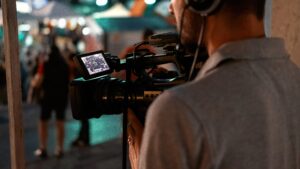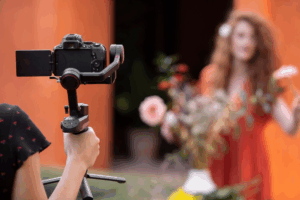In today’s dynamic event production landscape, capturing every moment with precision and creativity is paramount. Multi-camera setups have revolutionised event videography by allowing filmmakers and production teams to record from multiple angles simultaneously. This technique enhances the storytelling experience and provides a richer, more engaging video that truly reflects the event’s atmosphere.
This article explores the key benefits of multi-camera videography for the event videographer, how to execute it effectively, the equipment involved, and the role of expert editing in creating a seamless final product.
The Power of Multi-Camera Videography
Multi-camera videography transforms event coverage by capturing every moment from multiple perspectives simultaneously. This approach enriches the storytelling experience, ensuring no detail is missed and providing dynamic visuals that engage audiences more deeply.
Diverse Angles for Comprehensive Coverage
One of the most significant advantages of using multiple cameras is the ability to capture a variety of perspectives. Instead of a single, static viewpoint, multi-camera setups enable videographers to showcase the event from different angles — wide shots, close-ups, audience reactions, and detail shots.
This diversity enhances the narrative by giving viewers a fuller understanding of the event’s scope and emotional highlights. Whether it’s a wedding, conference, concert, or corporate event, multiple angles create visual interest and maintain engagement throughout the video.
Synchronisation for Smooth Transitions
Synchronisation between cameras is critical for a professional-looking final video. When cameras are perfectly synced, editors can switch between shots seamlessly, maintaining the flow of the event without noticeable jumps or awkward cuts.
Modern production teams use timecode synchronisation or audio waveform matching to align footage from multiple cameras accurately. This precision allows for dynamic storytelling and ensures that every key moment is covered without interruption.
Essential Equipment for Multi-Camera Event Videography
Successful multi-camera event videography relies on high-quality equipment, including multiple synchronised cameras, professional audio gear, and sturdy tripods or stabilisers. Additionally, a reliable switcher or control system helps manage live feeds, while editing software is essential for seamless post-production.
Cameras and Lenses
Choosing the right cameras and lenses is foundational for high-quality multi-camera coverage. Often, videographers use a mix of wide-angle lenses to capture the overall scene and zoom lenses for detailed close-ups. Consistency in camera models and settings helps maintain uniformity in colour and exposure, simplifying post-production work.
Tripods, Stabilisers, and Mounts
Stable and flexible mounting solutions are essential. Tripods provide steady base shots, while gimbals and stabilisers allow for smooth movement and tracking shots. Creative mounting options, such as overhead rigs or handheld setups, add depth and variety to the footage.
Audio Equipment
Clear and synchronised audio enhances the immersive quality of event videos. Multi-camera shoots often include separate audio recorders or wireless microphones to capture speeches, performances, or ambient sound clearly. Integrating this audio during editing enhances the overall viewer experience.
Executing Multi-Camera Shoots: Best Practices
Executing a multi-camera shoot requires careful planning, clear communication, and precise timing to capture every important moment from different angles. Coordinating camera operators and using synchronised timecodes ensure smooth footage alignment, while anticipating key scenes enhances storytelling quality.
Planning and Coordination
Successful multi-camera shoots start with meticulous planning. Production teams coordinate camera placement, angles, and movements in advance to avoid overlapping shots and blind spots. Understanding the event schedule and key moments ensures cameras are positioned to capture essential content.
Communication During the Event
Effective communication among camera operators is vital. Using headsets or walkie-talkies allows the team to adjust shots in real time and cover unexpected developments smoothly. This coordination helps maintain consistent coverage and maximises the value of each camera.
Capturing Key Moments Multiple Times
With multiple cameras rolling simultaneously, every important moment is captured from different perspectives. This redundancy is invaluable during editing, offering various options to highlight emotional expressions, reactions, and event details.
The Role of Editing in Multi-Camera Videography
Editing is crucial in multi-camera videography, seamlessly combining footage from various angles to create a cohesive and engaging story. Skilled editors synchronise clips, select the best shots, and use smooth transitions to maintain the event’s energy and flow.
Seamless Cutting Between Angles
Editing multi-camera footage requires skilful cutting between angles to enhance storytelling. Editors select the most compelling shots, switching between wide and close-up views to emphasise important moments and maintain pacing.
Colour Correction and Matching
Post-production includes colour grading to ensure visual consistency across all camera feeds. Matching colour tones and lighting between different cameras creates a cohesive look and professional finish.
Enhancing the Narrative Flow
Editors use the footage to build a narrative that reflects the event’s energy and message. By combining synchronised angles, natural audio, and visual effects, the final video delivers a polished story that resonates with audiences.
Conclusion
Multi-camera setups have become an essential tool in modern event videography. By capturing diverse angles, ensuring precise synchronisation, and employing skilled editing, production teams like those at SD Imaging can create compelling event videos that engage viewers and tell the full story. For videographers and clients alike, multi-camera coverage offers unmatched creativity, quality, and professionalism, transforming simple recordings into memorable cinematic experiences.
Frequently Asked Questions
1. What types of events benefit most from multi-camera videography?
Multi-camera setups enhance weddings, concerts, corporate events, conferences, and any event where capturing multiple perspectives adds value.
2. How do videographers synchronise multiple cameras?
Synchronisation is achieved using timecode, audio waveforms, or dedicated synchronisation devices to align footage perfectly.
3. Does multi-camera videography require special editing skills?
Yes, editing multi-camera footage involves selecting the best shots, colour matching, and creating smooth transitions to maintain narrative flow.
4. Can multi-camera footage be used for social media content?
Absolutely. Multiple angles and shots provide versatile content suitable for highlights, teasers, and promotional clips.
5. What equipment is essential for a successful multi-camera shoot?
Key equipment includes cameras with varied lenses, tripods, stabilisers, quality audio gear, and communication tools for coordination.



